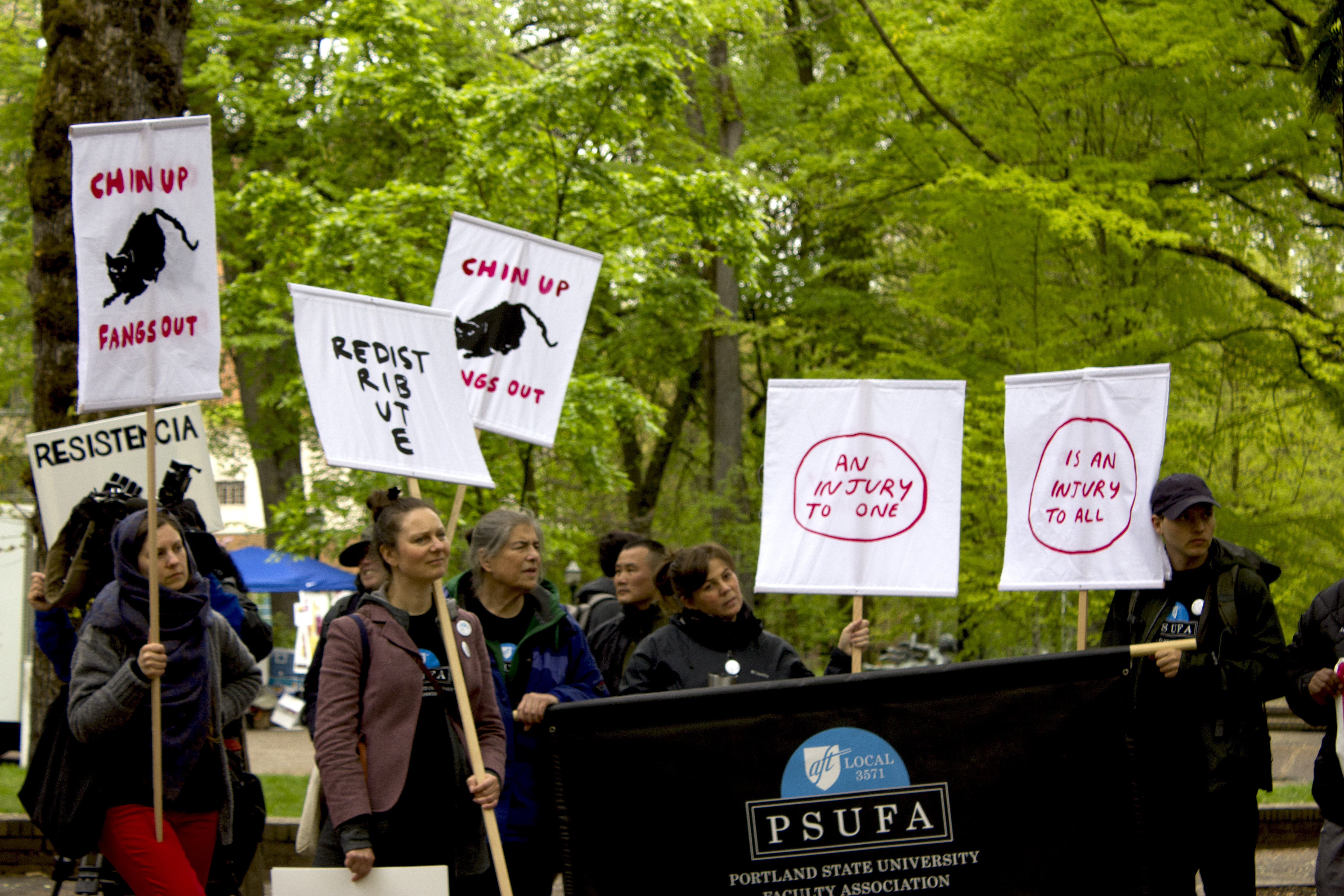This spring, adjunct faculty members of the Portland State University Faculty Association began hearing that adjuncts were being let go from the Theater and Film Department. Adjuncts in other departments reported instances of receiving their course assignments for fall 2017 later than usual, so they fear they will not have time to appeal their unemployment. Some adjuncts fear for their ability to find jobs outside PSU and afford health insurance or basic living costs.
At PSU, an adjunct faculty member who works less than a 0.5 Full Time Equivalent does not qualify for health insurance or retirement benefits. Many adjuncts work at one or two other local colleges or universities to make up 40 or more hours a week. Adjuncts are awarded contracts on a term-by-term, yearly, or two-year basis depending on their tenure at the university, number of credit hours they have taught, and performance.
Adjunct professors are the largest single faculty group on campus, making up 47 percent of the population, and taught 34 percent of all credit hours at PSU in the 2015–16 academic year.
Dr. Sue Brower, a theater and film instructor, has taught at PSU for 21 years. Brower received a form letter from her department head that said she and other adjuncts would be let go for budget reasons, without any acknowledgment of her service to the university.
“Being an adjunct is a very isolated position, at least where we are,” Brower said. “We don’t go to faculty meetings, [and] because a lot of adjuncts work elsewhere it’s not like there’s a regular way of seeing one another. We are not really part of the full-time culture. We go in and we teach and that’s kind of it.”
Brower said she is fortunate that she has a family and does not have to support herself on her teaching income alone. However, other adjuncts who work at multiple private and public colleges are not so lucky. “Those folks are gonna get hit in all sorts of ways because [Portland Community College] might be doing the same type of cuts,” Brower said. “There’s this state thing to control the budget, so I think that it’s going to be hard for people to find jobs.”
Some representatives from PSUFA rallied for May Day in Shemanski park on May 1, waving signs that read “Redistribute” and “Chin Up Fangs Out.” Ariana Jacob, an adjunct art professor, discussed how adjuncts make significantly less than full-time professors and can lose their jobs at any time.
“Our goal is to have pay parity so that we’re paid at the same level for the same credit hours as full-time faculty, and we’re also trying to figure out ways for there to be more job security in general for adjunct faculty,” Jacob said, adding that the PSUFA executive council altogether has hundreds of thousands of dollars in student debt.
Because each department pays faculty at different rates, it is difficult to say how adjunct pay compares to that of full-time professors. As of 2017, 4 percent of PSU’s general fund went to adjunct salaries. In the last five years adjunct salaries have risen by 14.7 percent and tenured-track faculty salaries rose by 9.1 percent.
Adjunct professor Sara Bernstein, who got her B.A. at PSU, has been a faculty member for over three years and recently turned down work at Pacific Northwest College of Art for the fall in order to work solely at PSU. Now that her classes have been cancelled, she no longer has a job.
Bernstein said PSU is dealing with budget cuts in a “typical corporate model.” PSU has chosen to cut the most vulnerable people from the university, Bernstein said, instead of from the administration.
PSU has never had adjunct representation on the Faculty Senate, though this year the senate has considered an ex-officio nonvoting adjunct seat.
According to Anna Gray, PSUFA vice president and adjunct art instructor, an adjunct seat is yet another monetary cost to the school. “While a position on the senate is [already] included in a full-time salary, an adjunct faculty member would need to be compensated,” Gray said.
“The cost would be small—a few hundred dollars over the course of the year,” Gray added in an email. “The hold up seems to be where the money would come from at this point.”
Gray referred to the collective bargaining agreement that outlines, “adjuncts are paid at a rate of $25/hour for extra-instructional service. So if you add up the nine months of senate meetings…that is where I get that amount,” Gray said.
Are priorities out of line?
“I don’t know why they don’t cut from the top,” Brower said of PSU’s 2017–18 budget cuts. “From the top down, to those of us on adjunct wages, the [administrative] salaries are a lot, and they are. I also think there is an endemic problem with university systems.”
“A lot of the budget seems to be going to capital projects and buildings,” Gray said.
“We understand this funding comes from a different source than funding for wages and benefits, but it’s a question of fundraising priorities.” Gray said in a follow-up email. “Funding buildings is a lamentable decision when there is such a need to be investing in people and jobs.”
Vice Provosts Scott Marshall and Shelly Chabon explained to the Vanguard that budget cuts have been felt all over the university. Many administrative departments, said Marshall, “have been held flat or cut for at least, I believe, four years, while costs have increased, so essentially a cut. [This] has increased frustration.”
According to the provosts, Wiewel makes less than most presidents and tuition is less expensive in comparison to other public universities.
Even with an 8.4 percent tuition increase, PSU’s in-state annual tuition would be over $600 cheaper than the national public university average.
PSU’s most significant building proposal, a $100 million tower at Southwest 4th and Montgomery Street, would reportedly be paid for by fundraising efforts by both PSU and Oregon Health and Sciences University, meaning it would not take away from PSU’s education fund. The City of Portland and PCC will pay hundreds of thousands of dollars each to use space in the building.
Chabon explained that the university has successfully bargained in the last year to expand a health care fund that part-time faculty can use to help pay for health insurance, including two annual excellence awards for adjunct faculty which provides a $1,000 award and a professional development fund. Adjuncts can also qualify for one-year appointments after faculty have taught 8 credits or for two years, whichever comes first. However, according to Bernstein, many adjuncts have not yet seen those contracts this year.
Health insurance gets the back seat
Bernstein said she and many other adjunct professors rely on the Affordable Care Act for their health insurance. Bernstein does not qualify for any subsidies and said that if she loses her insurance coverage, which does not include dental insurance, she will not have any other options. Other PSUFA members claim to make a low enough income that they qualify for Medicaid.
Senate Bill 196, which currently in the Oregon Senate, would provide part-time faculty members working more than 0.5 FTE at one or more public higher education institutions with 90 percent of their health insurance fees paid by the state.
“A lot of people teach between public and private schools,” Jacob said, meaning they would still be responsible for their own health insurance, even though they could be working more than full time.
On Tuesday, March 28, members of the Senate Committee on Education read a testimony from one current and one former PSU adjunct professors advocating for SB 196. Shirlee Geiger, who worked at both PSU and PCC in 2006 when she was diagnosed with breast cancer, said the health insurance funds offered by both colleges could not help to cover a potentially life-saving medication on top of Geiger’s treatment bills. Only after PCC successfully bargained for PT faculty health care, could Geiger pay several years’ worth of cancer treatment.
Geiger wrote, “When I was teaching more classes—and many more students—than any of my ‘full-time’ colleagues, even through the chemotherapy, it was hard to understand why I had to pay so much more for such inferior health care.”
Shane Abrams, another adjunct at both PSU and PCC wrote, “I have already experienced the precarity of my employment: I have had classes cancelled last minute due to low enrollment, thus reducing my income by no small percentage; I have competed for institutional resources, reducing the amount of time I can dedicate to students, and, of primary concern here, I have spent late nights fretting over my access to the basic human need of health care.”
Painful present, future unseen
Because PSU’s final cuts have yet to be determined, it is unclear whether or not more adjuncts will be cut from the faculty. Marshall and Chabon both echoed, “We can’t say enough how much we appreciate adjunct faculty. They do a lot, not for very much, and we realize it’s not an easy existence for them.”
Chabon said the administration might do better to inform the campus of what the administration does and how it directly affects students. “We hate to think about it as us vs. them,” Chabon said. “To think about a loss of faculty is painful for any of us.”
Brower’s superior did eventually thank her for her service. “I’ve had some really lovely students and I just appreciate them so much,” Brower said. “We get students [for whom] it’s a struggle to come to PSU for all sorts of reasons. I love that about them. It’s not being handed to them, it’s not easy for them financially or personally to make it for different reasons, but they’re here and I really love that about them.”






